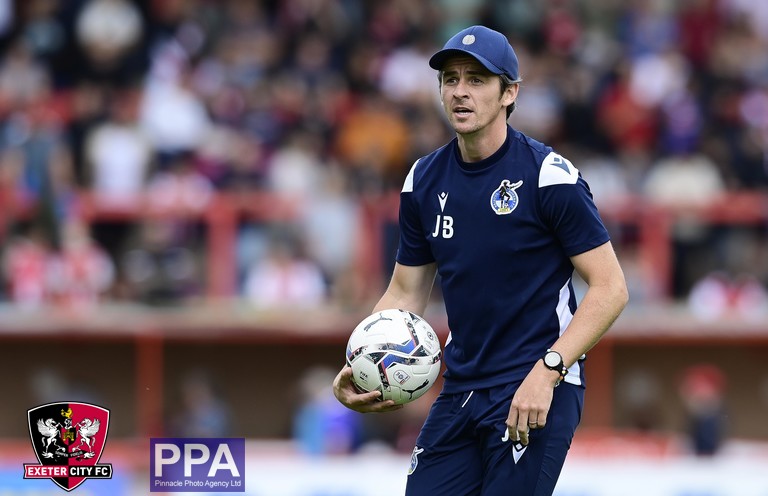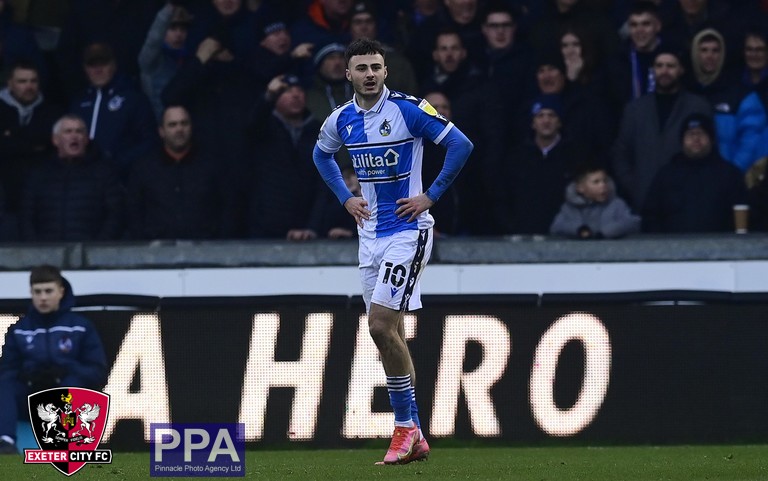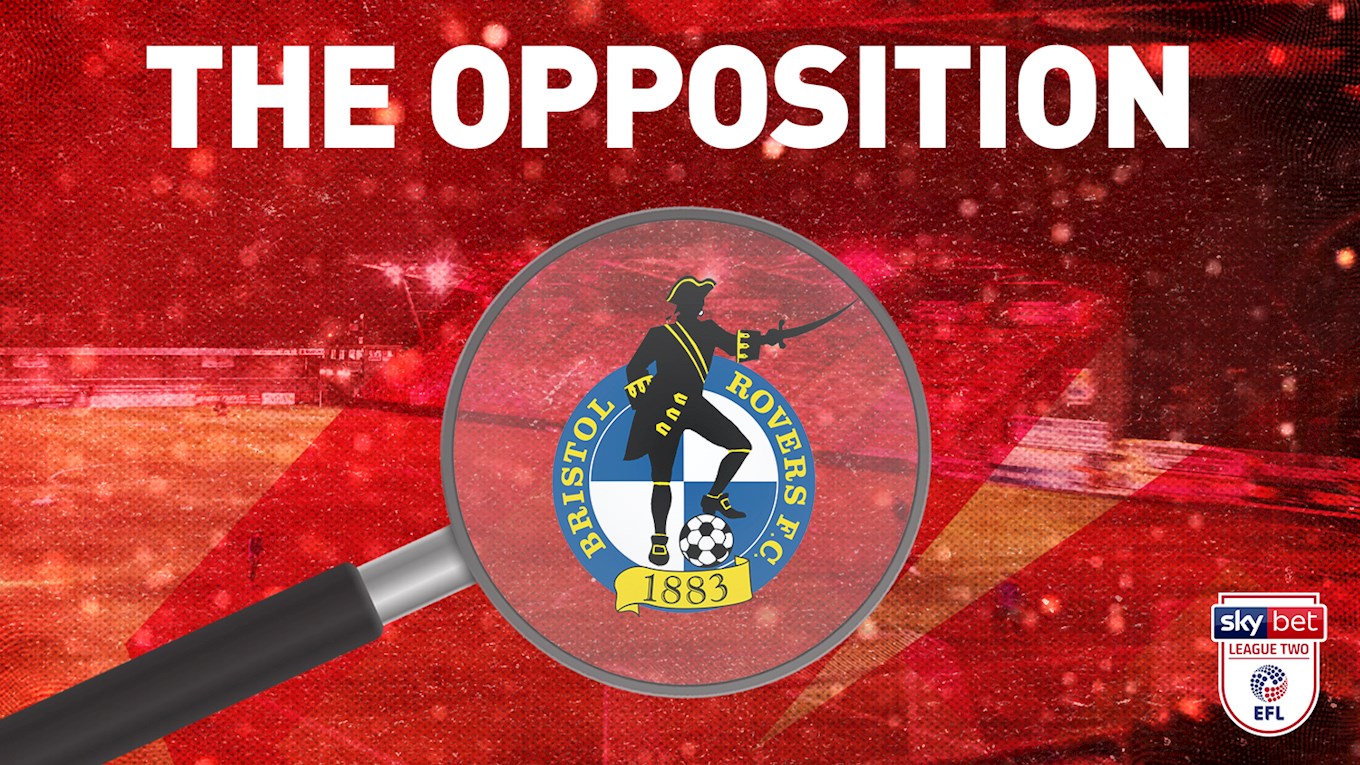The Grecians make their shortest trip on the road on Saturday to face Bristol Rovers at the Memorial Stadium.
So bury your treasure and read up all about the Pirates.
- Founded: 1883
- Nicknames: The Pirates, The Gas
- Honours: Third Division (S)
- Home Kit: MACRON Blue and white quartered shirts, White shorts and blue shorts
- Away Kit: MACRON Yellow and green quartered shirts, yellow shorts and socks.
- Form: LDWWW (9th in League Two)
Formed on the Stapleton Road in 1883, ‘Eastville Rovers’ went through a number of name changes prior to sticking with Bristol Rovers. In the 1888/89 season, The Pirates claimed the Gloucestershire Senior Cup before turning professional in 1897. Rovers’ nickname derives from the infamous maritime history of the City, whereas ‘The Gas’ was adopted from the term used by rivals City, where Eastville Stadium laid next to a gasworks.
Bristol is one of Britain’s largest cities built heavily on its accessible waterways and sadistic past. The City was a major trade port for the British Isles during the 15th and 16th Centuries. At the height of the slave trade more than 2,000 ships sadly exported half a million people to work in America.
Bristol’s modern economy is built on the creative and aerodynamic industry with Airbus one of the largest employers on the Avon. One of the UK's most popular tourist destinations, Bristol was named the best city in Britain in which to live in 2014 and 2017, and won the European Green Capital Award in 2015.
Rovers were an original member of the Third Division in 1920 and won the division in 1952/53, with their first Football League honour. The Pirates repeated the feat in 1989/90 and managed to reach the dizzying heights of Division 1 (modern Championship) in 1992. Rovers have a strange stat of the most players to have scored four goals in a single match, without a player scoring five. A staggering 12 players have completed a four-goal haul for the Gas including Sydney Leigh in 1921, against Exeter City, and a certain Jamie Cureton who netted four against Reading in 1999.
In 2015, The Gas dropped out of the Football League but completed an immediate return, with a play-off win the following season, bouncing with back-to-back promotions. Last season Rovers stumbled to a measly 24th place finish.
Rovers has romped to three straight victories in the past three games so will City will need some guile to break Barton’s momentum.
Manager
Joey Barton is currently Bristol Rovers manager. The controversial former Premier League midfielder played for Manchester City and Newcastle United during his career.

He joined the Memorial Stadium as Boss in February, his second managerial appointment after Fleetwood Town.
Having celebrated his year anniversary during the week, Barton is winning back the Rovers fans with the clubs best form run of the season.
Stadium
- Name: Memorial Stadium
- Capacity: 12,296
- Year opened: 1921
- Record Attendance: 12,011 (vs West Bromwich Albion, 9th March 2008)
- Address: Filton Avenue, Horfield, Bristol, BS7 0AQ
Opened to commemorate the fallen Bristolian rugby players after the First World War, the Memorial Ground has been a rugby ground since its construction. The Bristol Bears had been tenants of the Horfield stadium until 2014 when the rugby club set their ambitions higher and moved to Ashton Gate.

Rovers have been playing at the Mem since 1996 after moving from Twerton Park. There have been many plans to expand the stadium, most notably to an 18,500 all-seater in 2007. Planning permission was granted though delays and a club financial crisis made the development untenable.
In 2017, new owners the Al-Qadi Family reinstated their commitment to expand the ground beginning first with redevelopment to the in-house facilities.
Ones To Watch
Aaron Collins
Aaron Collins is Rovers’ key man this season. A highly-rated talent, the 24-year-old possesses a good degree of EFL experience, with spells at the likes of Newport County, Tranmere Rovers, Morecambe, Colchester and most recently at Forest Green Rovers.

It was A. Collins and A. Collins who both found themselves on the scoresheet when Exeter met Forest Green on Boxing Day (though Archie trumped him with his piledriver). That goal was one of 11 for Aaron last term which guided the Club on the Hill to the League Two Play-offs, where he netted in the thrilling second leg against Newport County. That proved his final game for Forest Green and joined the Pirates in the summer.
Collins netted his tenth goal in all competitions on Tuesday night as he seeks to propel Rovers into the Play-off spots before May.
Head to Head
The Pirates usually offer exciting affairs and this year marks the 100th anniversary of the inaugural fixture- a 5-0 victory for the Bristolians. Not every game has been as grim a reading for City fans with some fans remembering the brilliant 2-0 away victory in 2011. That’s proven to be our last victory on the Severn estuary, but the two Westcountry adversaries lock horns again this weekend.
This season City have netted nine against the Gas with all the goals coming in the first halves of each game.
- Exeter City wins: 31
- Draws: 31
- Bristol Rovers wins: 31
Recent encounters
Exeter City 5 Bristol Rovers 3 | Papa John’s Trophy | St James Park | November 10, 2021
City were five-nil up at half time through goals from Josh Coley (2), Podge Amond (2) and Tim Dieng as the Grecians somewhat comfortably booked their place in the Second Round of the EFL Trophy
Exeter City 4 Bristol Rovers 1 | Sky Bet League Two | St James Park | August 21, 2021
The Grecians opened their scoring account for the season in style as Matt Jay, Dieng and Harry Kite found themselves on target.
Exeter City 2 Bristol Rovers 0 | Football League Trophy | St James Park | November 13, 2018
Jonathan Forte and Joel Randal were on target as City blew away their Westcountry adversaries in the FL Trophy group stage.
And Finally
The song which is synonymous with Rovers is "Goodnight, Irene", which was written by Lead Belly.
Opinions differ as to how this came about but it is thought to have become popular in the 1950s when a version of the song was in the British charts. It is believed that John Clapham is responsible for the song as he used to work at Eastville stadium for the greyhound racing and the last record he would play at the end of the night was "Goodnight Irene" also having a daughter called Irene, the record would then be left in the player and was played at the football.
